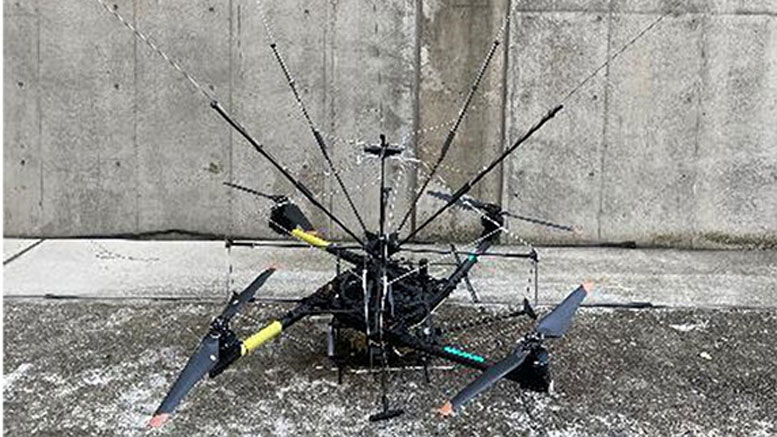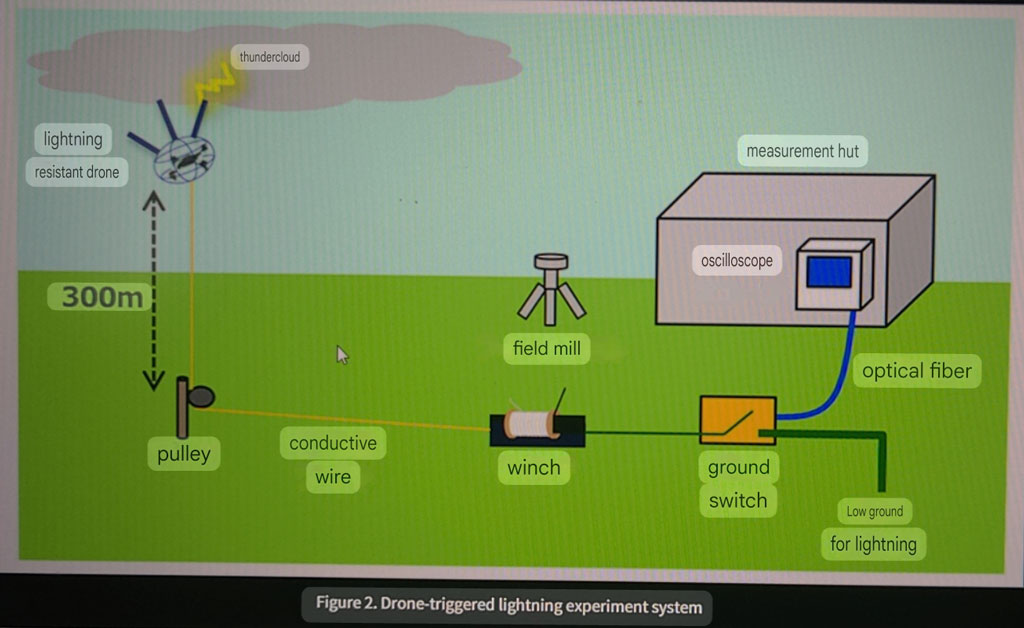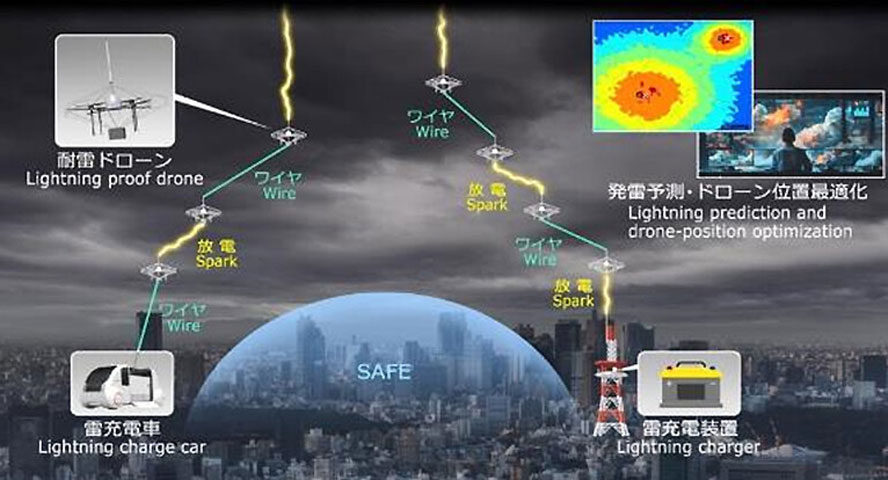World's first drone system for fighting lightning protects cities and infrastructure
NTT's drones flew in lightning-resistant cages and hope to, some day, tap and store the power of thunderclouds.

The Nippon Telegraph and Telephone Corporation (NTT) boasts that it has designed the world’s first lightning triggering and guidance system that leverages flying drones (via machine translation). After successful trials earlier this year it is hoped that networks of these drones can be installed in cities and key infrastructure as a preventative protection measure.

Lightning damage isn’t as rare as many an old adage might suggest, according to the stats shared by NTT. Its PR bulletin says that every year in Japan there is 100B to 200B Yen (up to $1.4B) worth of damage caused by lightning – and then there is the human cost to consider. Meanwhile, conventional lightning rods don’t provide as wide coverage as desirable, or might be tricky to install (e.g. wind turbines).
With the above in mind NTT set up an experiment to see if drones can be used to prevent lightning damage. The firm used ground monitoring equipment to judge the danger of lightning in an area. And basically, when thunderclouds approached and electric field fluctuations observed, a drone was sent up to intercept.
These are not kamikaze drones - they are equipped with a lightning-resistant cage. In a test flight on Dec 13, 2024, a drone attached to a ground wire was flown to 300m altitude to approach a suspected thundercloud. NTT says it then observed a massive electrical pulse and claims that it achieved “the world's first successful lightning induction using a drone.”
When the lightning struck the drone, it could continue to fly thanks to the cage protection (though it part melted). It is key that the drone could remain airborne after being zapped, says NTT and before this live trial it had successfully tested them at up to bursts of 150,000 Amps.

NTT intends to continue refining its lightning triggering and guidance drones. To augment the above study and trials it is looking at improving lightning location prediction accuracy. Moreover, there are plans to research and development into storing the lightning energy that is safely diverted.
Follow Tom's Hardware on Google News to get our up-to-date news, analysis, and reviews in your feeds. Make sure to click the Follow button.
Stay On the Cutting Edge: Get the Tom's Hardware Newsletter
Get Tom's Hardware's best news and in-depth reviews, straight to your inbox.

Mark Tyson is a news editor at Tom's Hardware. He enjoys covering the full breadth of PC tech; from business and semiconductor design to products approaching the edge of reason.
-
mlindefar How about a helium balloon, and a copper wire?Reply
Why overcomplicate matters. This sounds like a waste of money -
chaz_music I thought someone did this many years ago with a dirigible. And there has been a group in Florida researching diverting lightning for years, starting with launching rockets with a wire attached going into clouds. The Faraday cage idea is a good one, though.Reply
There isn't as much energy that you can store as most people think. A single one MJ blast would only run the typical house for less than 10 minutes, considering 2KW average power usage. Given the cost of the energy storage system, is that cost effective? How many lightning strikes would you need to recoup the installation cost? -
JRStern Reply
I get this from Google:chaz_music said:I thought someone did this many years ago with a dirigible. And there has been a group in Florida researching diverting lightning for years, starting with launching rockets with a wire attached going into clouds. The Faraday cage idea is a good one, though.
There isn't as much energy that you can store as most people think. A single one MJ blast would only run the typical house for less than 10 minutes, considering 2KW average power usage. Given the cost of the energy storage system, is that cost effective? How many lightning strikes would you need to recoup the installation cost?
A typical lightning strike releases between 200 and 7,000 megajoules (MJ) of energy. An average negative lightning bolt, for instance, might transfer about 450 MJ. Larger, positive lightning strikes can release even more, reaching 42 gigajoules (42,000 MJ).
I don't think they can story anything if it comes in as a standard strike, they must be thinking they can drain it under controlled circumstances ... somehow. After all the potential is there, on the ground, before the strike. That just might work and be super-clever.
The wire they drag into the sky must be super-thin and can't carry any real power, but if it attracts more potential, ... somehow ... it's a brave and crazy experiment, the Japanese tend to go for stuff like this. -
Notton Reply
because thunderstorms bring unpredictable turbulent wind, and rain will soak and add weight to the balloon, making it not as buoyant.mlindefar said:How about a helium balloon, and a copper wire?
Why overcomplicate matters. This sounds like a waste of money
Not that I'm convinced a drone is suitable for such weather either.
IDK if the drone is intended to fly into the clouds, but there is potential rotor icing if so. Even if not flying into clouds, heavy rain, micro-bursts, and/or hail can still bring the drone down. -
wakuwaku Reply
How about going to school and using your brains to waste less money?mlindefar said:How about a helium balloon, and a copper wire?
Why overcomplicate matters. This sounds like a waste of money
Because helium is an even more waste of money?
https://www.bbc.com/future/article/20250331-why-helium-shortages-are-worrying-the-world
Helium is low in supply high in demand, making it expensive and supplied/acquired based on priority. I doubt these guys will get any helium at decent pricing, if they managed to get any at all.
Helium balloons cannot be controlled. These guys are aiming to cover a specific area asap. Can your helium balloon fly as near as possible to where you want it to be as fast as possible?
Drones can also be autonomous. With Japan's shrinking population, making AI do all these ---- is the only option they might have. Are you gonna volunteer yourself to go to Japan, sit in a store room, stare at the sky and operate all the balloons there?
If you are going to equip them balloons with motors and propellers and brains and batteries to power them, you are already making a drone....just don't waste money and time waiting for your turn to get your share of helium, if you will ever get it, and use a drone? -
TryRebooting Reply
The wire just needs to last long enough for plasma(which is very conductive) to form, and I believe a thin wire would work for that. You can make plasma in a microwave by slicing a grape almost in half just leaving a small part of the skin between the 2 halves.JRStern said:I get this from Google:
A typical lightning strike releases between 200 and 7,000 megajoules (MJ) of energy. An average negative lightning bolt, for instance, might transfer about 450 MJ. Larger, positive lightning strikes can release even more, reaching 42 gigajoules (42,000 MJ).
I don't think they can story anything if it comes in as a standard strike, they must be thinking they can drain it under controlled circumstances ... somehow. After all the potential is there, on the ground, before the strike. That just might work and be super-clever.
The wire they drag into the sky must be super-thin and can't carry any real power, but if it attracts more potential, ... somehow ... it's a brave and crazy experiment, the Japanese tend to go for stuff like this. -
newtechldtech Reply
You can call it a Robotic Kite if you wish .. or Kite droneAngelusF said:Why not just a guy flying a kite? Seemed to work back in the day. ⚡ -
Amdlova Reply
on you tube see some one using super mega high capacitor to make a perfect thunder rail gun lolTryRebooting said:The wire just needs to last long enough for plasma(which is very conductive) to form, and I believe a thin wire would work for that. You can make plasma in a microwave by slicing a grape almost in half just leaving a small part of the skin between the 2 halves.
lix-vr_AF38View: https://www.youtube.com/watch?v=lix-vr_AF38 -
JRStern Reply
Yes I saw that, but note it only has a range of thirty feet.Amdlova said:on you tube see some one using super mega high capacitor to make a perfect thunder rail gun lol
lix-vr_AF38View: https://www.youtube.com/watch?v=lix-vr_AF38